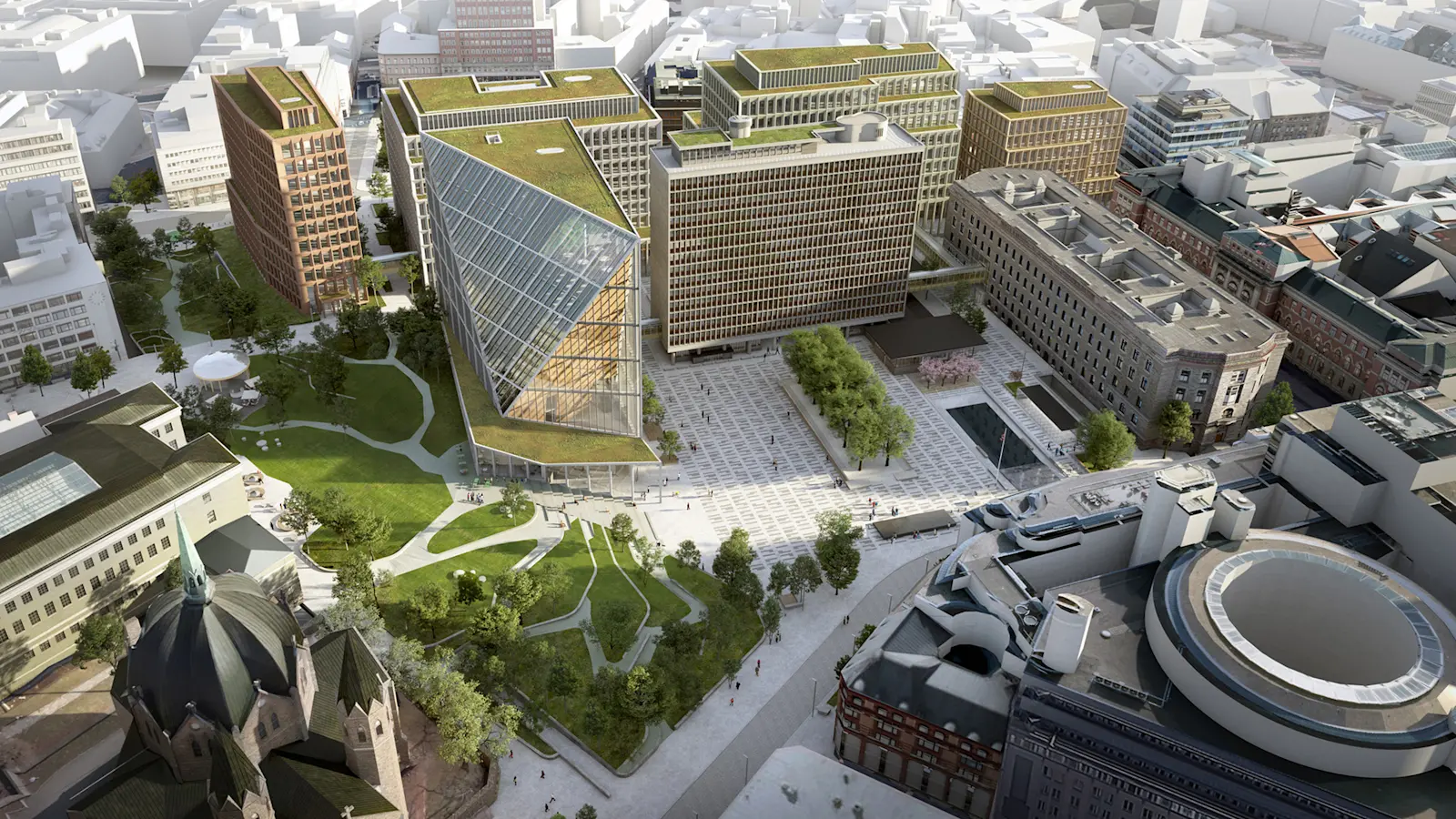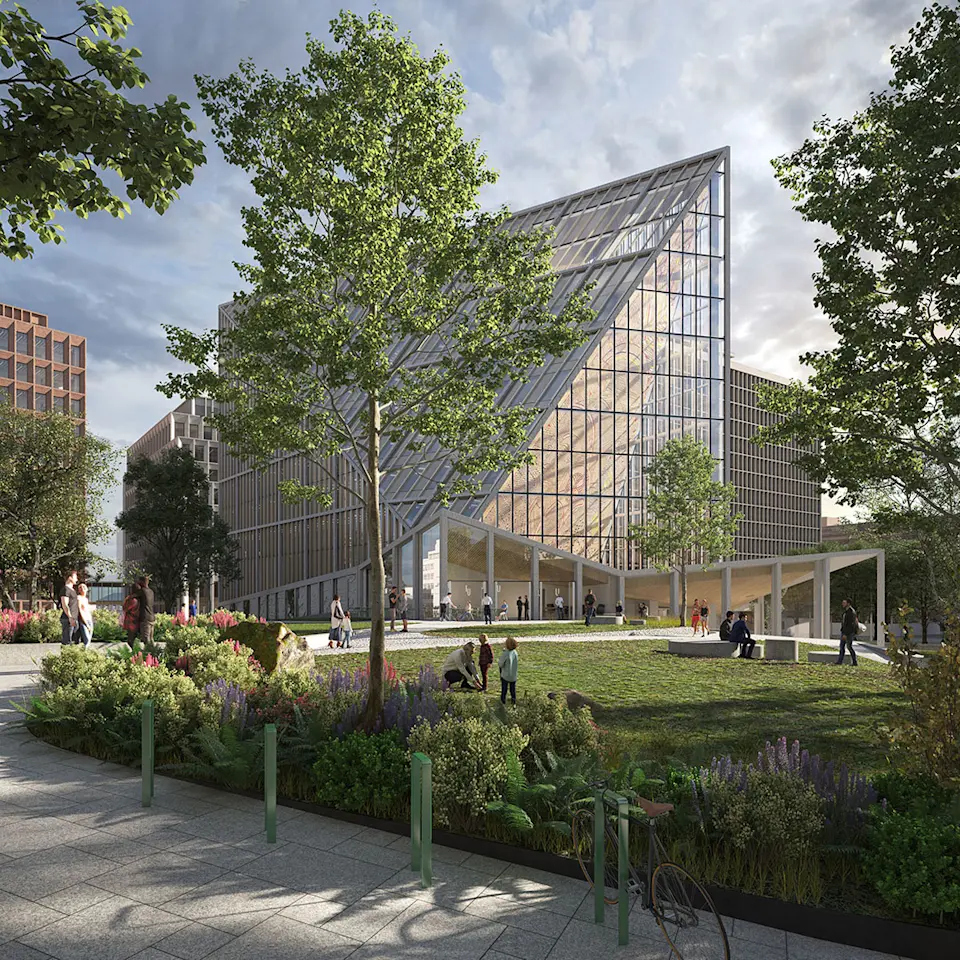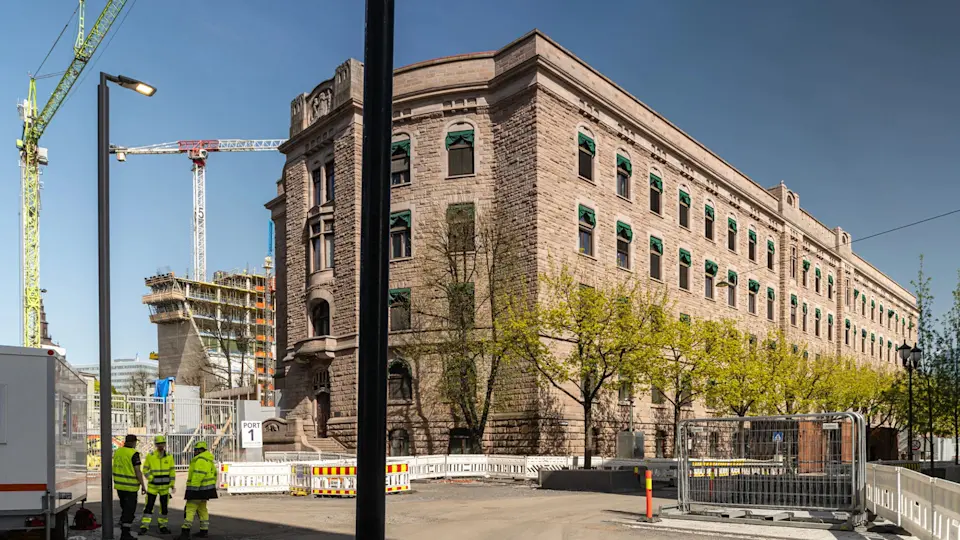& Construction

Integrated BIM tools, including Revit, AutoCAD, and Civil 3D
& Manufacturing

Professional CAD/CAM tools built on Inventor and AutoCAD
The Oslo terror attacks in July 2011 left 77 people dead and 200 injured, and rendered several government buildings unusable. More than 1,800 civil servants found themselves without a workspace—including the Prime Minister. Safe premises had to be secured around the city for six entire ministries, disrupting operations and upending long-established workflows.
In the aftermath, planners at the Statsbygg (Norwegian Directorate of Public Construction and Property) proposed a bold vision: build a new government quarter that would strengthen the existing site’s symbolic and historic status while representing a positive future direction.
The project would be an affirmation of Norwegian values: freedom, sharing, collaboration, and sustainable architecture built at a human scale. But state rules around data protection and national security meant managing design and construction would need a decidedly un-open approach. IT systems had to be offline, cloud platforms were forbidden, teams had to be broken up into task groups with a well-defined division of labor. Information sharing happened on a need-to-know basis and siloed working became the order of the day.
Making it a success would require innovation, tenacity, structured collaboration, and a willingness to rethink systems and processes in the pursuit of a common goal.
Now under construction, the new Regjeringskvartal (RKV) quarter is being expanded to include seven buildings connected by interlinked public spaces. Five new builds will be linked to two heritage buildings set for refurbishment.
By gathering all national government ministries into one concentrated government center, planners aim to embed organizational flexibility that will allow for future changes while also simplifying physical interactions between people and departments.
Given the events that initiated the project and the institutions the buildings would represent, planners gave serious thought to societal issues. To what extent should Norwegian identity and values be reflected in the architecture? Oslo is one of Europe’s fastest-growing capital cities and in the midst of significant and sometimes controversial changes to its built environment. How would citizens react to even more dramatic change?
Respecting historical continuity became an important principle, with G-blokken (1906) and Høyblokken (1958) damaged in the 2011 attack and memorialized in the public imagination. These buildings are considered important period statements worthy of preservation.
Both are being modernized and integrated with the rest of the 125,000-square-meter site. The end result will be a ring of interconnected government buildings that, while taller than the historic city center, incorporate stepped facades and terraced levels to harmonize with the existing urban scale at street level. The design re-establishes historic pedestrian routes and creates new connections, integrating the Government Quarter with Oslo’s surrounding city fabric through carefully considered passageways and public spaces. Open green spaces make the site accessible to the public from all sides, while a series of bridges on each building’s first floor create a continuous connected working environment.
The vision is for open and horizontal spaces that promote collaboration, yet the 12-firm consortium tasked with bringing the project to life also had to adopt management practices constricted by tough state security protocols.
Norwegian security laws forbid cloud services and online storage for confidential building projects like this, so access to systems had to be strictly controlled. “So, all the data—models, drawings, you name it—had to stay offline,” says Morten Ræder, senior architect at Nordic Office of Architecture and the project’s interdisciplinary BIM coordinator. “The design teams had to be split into silos and information shared on a need-to-know basis. It was all about minimizing the risk, which in today’s international political situation obviously has grown increasingly important.”
Statsbygg’s digital strategy demands a model-centric approach to design processes to keep workflows lean and everyone working from one single source of truth. With more than 100 design models being worked on by 150 or more architects and engineers across 12 partners and multiple contractors, offline working threatened to become a serious obstacle to efficiency and timelines.
Inevitably, offline working requires more face time and introduces technical complexity. To keep meetings to a minimum and still maximize efficiency, automating processes would be key. Off-the-shelf tools wouldn’t be enough.
“Our team had to innovate beyond standard market offerings,” says Ræder. “Autodesk Forge and BIM360|Autodesk Construction Cloud were not options, but Revit’s well-documented open API enabled the development of crucial automation scripts and scalable add-ins to enhance quality and productivity, maintaining model consistency across diverse teams and reducing the need for manual oversight.”
In practical terms, Revit’s customizable automation scripts allowed Ræder’s team to streamline tedious tasks such as tagging data objects with different project properties. An add-on was created to automatically update hundreds of thousands of discipline objects without the need for human intervention. The project's success was greatly facilitated by having developers with architectural and engineering backgrounds embedded within the design group, working directly with end users and the client's IT department.
Transforming tagging from a chore to an automated process reduced the need for manual labor and increased data accuracy. It also gave architects and engineers more time to focus on the creative and intellectually stimulating aspects of the project.
Still, when so many people are working with so many models, model discrepancies become an issue. Autonomous design teams all work from the same Revit templates, so an extensive master data file was created to ensure the settings for 100-plus models were standardized.
The Revit add-in and bespoke scripts handled this, referencing master data rules for consistency then ensuring any changes entered in one model were seamlessly and bi- directionally updated across all referenced models.
“This really made quality assurance faster and easier,” adds Ræder. “Instead of tagging thousands of individual objects, we’d update just a few mass objects and that would sync across models automatically.”
Cutting out repetitive manual tasks has enabled Ræder to keep his building information modeling (BIM) team lean. Headcount savings and significant reductions in manual data handling have saved more than 10,000 hours and more than $4 million in project costs.
The bespoke add-in and automation scripts are also making it easier to hit the client’s BREEAM sustainability objectives. Significant design-stage sustainability outcomes have been achieved, which need reliable design and engineering data to forecast accurately. A few highlights:
Projected energy consumption has been reduced to 52 kilowatt hours per square meter per year.
The site’s lifecycle carbon footprint has been reduced by 34%.
Expected water runoff has been reduced by a whopping of 95% when compared to the existing site.
“Working in an offline environment was more restrictive than we initially thought, but overall, the surprises have been positive,” Ræder says. “I was truly amazed by how well everyone worked together. It wasn’t just within the design team, but also with the client’s IT department and the contractors’ BIM coordinators. Everyone went above and beyond to make things work, and they’ve taken our work even further onsite. Seeing that level of collaboration and innovation was inspiring.”
Mark de Wolf is a freelance journalist and award-winning copywriter specializing in technology stories. Born in Toronto. Made in London. Based in Zürich. Reach him at markdewolf.com.
AECO
Emerging Tech
Image courtesy of Norconsult.
AECO






